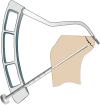Suspension button constructs restore posterior knee laxity in solid tibial avulsion of the posterior cruciate ligament
- PMID: 33675369
- PMCID: PMC8595177
- DOI: 10.1007/s00167-021-06510-1
Suspension button constructs restore posterior knee laxity in solid tibial avulsion of the posterior cruciate ligament
Abstract
Purpose: Dislocated tibial avulsions of the posterior cruciate ligament (PCL) require surgical intervention. Several arthroscopic strategies are options to fix the fragment and restore posterior laxity, including two types of suspension button devices: adjustable (self-locking) and rigid knotted systems. Our hypothesis was that a rigid knotted button construct has superior biomechanical properties regarding laxity restoration compared with an adjustable system. Both techniques were compared with standard screw fixation and the native PCL.
Methods: Sixty porcine knees were dissected. The constructs were tested for elongation, stiffness, yield force, load to failure force, and failure mode in a material testing machine. Group N (native, intact PCL) was used as a control group. In group DB (Dogbone™), TR (Tightrope™), and S (screw), a standardized block osteotomy with the osteotomized fragment attached to the PCL was set. The DB and TR groups simulated using a suspension button system with either a rigid knotted (DB) or adjustable system (TR). These groups were compared to a screw technique (S) simulating antegrade screw fixation from posterior.
Results: Comparing the different techniques (DB, TR, S), no significant elongation was detected; all techniques achieved a sufficient posterior laxity restoration. Significant elongation in the DB and TR group was detected compared with the native PCL (N). In contrast, screw fixation did not lead to significant elongation. The stiffness, yield load, and load to failure force did not differ significantly between the techniques. None of the techniques reached the same level of yield load and load to failure force as the intact state.
Conclusion: Arthroscopic suspension button techniques sufficiently restore the posterior laxity and gain a comparable construct strength as an open antegrade screw fixation.
Keywords: PCL; Posterior knee laxity; Suspension button; Tibial avulsion.
© 2021. The Author(s).
Conflict of interest statement
A. B. Imhoff is a consultant for Arthrex. P. Forkel and M. J. Feucht received fees for lectures from Arthrex.
Figures







Similar articles
-
Onlay Reconstruction of the Posterior Cruciate Ligament: Biomechanical Comparison of Unicortical and Bicortical Tibial Fixation.J Knee Surg. 2019 Oct;32(10):972-978. doi: 10.1055/s-0038-1672205. Epub 2018 Oct 3. J Knee Surg. 2019. PMID: 30282096
-
Biomechanical Properties of Different Fixation Techniques for Posterior Cruciate Ligament Avulsion Fractures.Arthroscopy. 2016 Jun;32(6):1065-71. doi: 10.1016/j.arthro.2015.10.013. Epub 2016 Jan 14. Arthroscopy. 2016. PMID: 26775734
-
Biomechanical comparison of 2 anterior cruciate ligament graft preparation techniques for tibial fixation: adjustable-length loop cortical button or interference screw.Am J Sports Med. 2015 Jun;43(6):1380-5. doi: 10.1177/0363546515574062. Epub 2015 Mar 12. Am J Sports Med. 2015. PMID: 25767269
-
Management of Posterior Cruciate Ligament Tibial Avulsion Injuries: A Systematic Review.Am J Sports Med. 2018 Mar;46(3):734-742. doi: 10.1177/0363546517701911. Epub 2017 Apr 24. Am J Sports Med. 2018. PMID: 28437619
-
[All-arthroscopic fixation of tibial posterior cruciate ligament avulsion fractures with a suture-button technique].Oper Orthop Traumatol. 2020 Jun;32(3):236-247. doi: 10.1007/s00064-019-00626-x. Epub 2019 Sep 6. Oper Orthop Traumatol. 2020. PMID: 31492968 Review. German.
Cited by
-
Arthroscopic fixation of chronic bicruciate tibial avulsion fractures: A case report.Chin J Traumatol. 2023 Mar;26(2):106-110. doi: 10.1016/j.cjtee.2023.01.002. Epub 2023 Jan 14. Chin J Traumatol. 2023. PMID: 36682986 Free PMC article.
-
Impact of screw design on refixation of solid avulsion fractures of the posterior cruciate ligament-A biomechanical feasibility study.J Exp Orthop. 2025 Mar 31;12(2):e70225. doi: 10.1002/jeo2.70225. eCollection 2025 Apr. J Exp Orthop. 2025. PMID: 40170708 Free PMC article.
References
-
- Ahmad SS, Hirschmann MT, Voumard B, Kohl S, Zysset P, Mukabeta T, Evangelopoulos DS, Ateschrang A. Adjustable loop ACL suspension devices demonstrate less reliability in terms of reproducibility and irreversible displacement. Knee Surg Sports TraumatolArthrosc. 2018;26:1392–1398. doi: 10.1007/s00167-017-4769-2. - DOI - PubMed
-
- Ayzenberg M, Arango D, Gershkovich GE, Samuel PS, Saing M. Pullout strength of a novel hybrid fixation technique (Tape Locking Screw) in soft-tissue ACL reconstruction: a biomechanical study in human and porcine bone. OrthopTraumatolSurg Res. 2017;103:591–595. doi: 10.1016/j.otsr.2017.01.006. - DOI - PubMed
MeSH terms
LinkOut - more resources
Full Text Sources
Other Literature Sources
Miscellaneous

